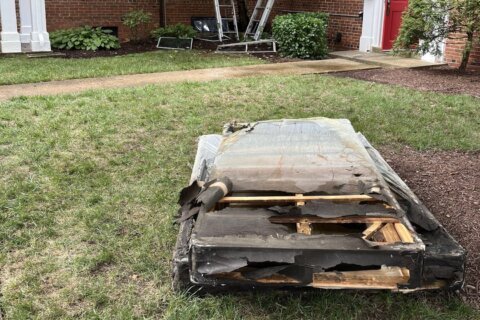The painstaking cleanup of what was once a World War I chemical weapons testing and disposal site, just southwest of the American University campus, is now complete, according to the project’s manager.
Demolition of the stately home at 4825 Glenbrook Road, in the Spring Valley section of Northwest D.C., began in November 2012, almost two decades after a contractor first unearthed buried military ordnance nearby.
For almost eight years, the U.S. Army Corps of Engineers has been looking for and removing remnants of potentially dangerous broken glassware and contaminated soil from the site, known as the American University Experiment Station.
“Excavation of all contaminated material is complete,” project manager Julie Kaiser told WTOP.
The cleanup of what the lawyer for the former homeowner called “the mother of all toxic dumps” began after digging and research indicated the likely presence of mustard gas and lewisite — an arsenic-containing blister agent — under the former home.
“We were happy to find that all of the soil and underlying saprolite, which did get sampled, was less than 20 parts of arsenic,” Kaiser said.
Saprolite is the rock under the soil, and the level of arsenic is comparable with naturally occurring levels found in soil, rock, water, and air.
“That was the deciding factor in the last excavation,” Kaiser said.
Starting in 2013, the Army Corps began excavating under the home’s foundation. Much of the work was done under a huge high-tech enclosure, which prevented chemicals from escaping into the neighborhood.
Tons of contaminated soil and glassware have been removed during the cleanup, which has taken place behind safety fencing that largely blocked view of worksite. During some of the project, workers in hazmat gear skimmed the soil with hand tools.
“It’s quite an accomplishment,” Kaiser said. “Given the amount of work, and level of protection we had to provide to not only our workers, but the entire community.”
Most of the work was accomplished without incident, but in 2017, seven workers were sickened and temporarily hospitalized.
Now, in the final stage of the project, the Army Corps is restoring the property.
“That includes backfilling, grading, compaction of soil, seeding,” to return the property to its natural condition before turning over the property to American University, which owns the land again.
Kaiser said when the property is returned to the university — perhaps this fall — it will include a grassy slope from the curb, a plateau, then another grassy slope to blend in with university property.
“The land will be clear for any and all use,” said Kaiser.
The Army Corps is well underway in testing more than 90 nearby homes within a half-mile radius of the World War I firing range to ensure homeowners don’t find munition remnants on their property.
The approximate location of the cleanup site can be seen in the map below:








